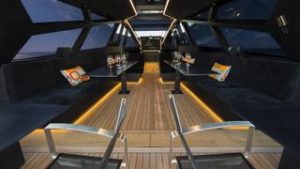Not for the first time recently, have we seen the granting of copyright protection on a project of interior furnishing.
Following the Court of Milan’s ruling which recognised copyright protection of Kiko’s concept stores, the Court of Venice was also called to pronounce – in the context of an interim proceedings – on the eligibility for copyright protection of a project of interior furnishing, specifically that of a yacht’s interior (interim order, Court of Venice, RG 2236/2018, published in November 2018).
The case originates from the realisation, by an architect, of a fully personalised layout, interiors and decor of the yacht “Checkmate”. Just the structural part of the yacht had been initially purchased from the boat vendor “Wally”.
The architect found that interior images and videos of the Checkmate yacht had been published on Wally’s website, as well as on other platforms (Vimeo and YouTube), without his consent and without mentioning his name as author. Instead, Checkmate’s interior design and styling was presented as a work of Wally itself.
The architect asked the Court of Venice to issue an interim order that would forbid Wally to use any interior image, drawing, project or video relating to the Checkmate yacht. In doing so, the architect invoked his copyright on the interior furnishing project (under article 2.5 of Italian copyright law).
In opposing the above request, Wally claimed that the interior furnishing project of Checkmate’s yacht was not eligible for copyright protection. In this respect, Wally’s main argument was that the architect’s proposed features: i) were already common (being already adopted by Wally itself), ii) lacked original character and iii) were merely functional. Wally also pointed out that the contested images had been published just for brokering purposes.
The Court of Venice recalled Italian case-law stating that: i) creativity can exist even when the work consists of simple ideas; ii) creativity is not constituted by the idea in itself, but by the form of its expression; iii) different works, from different authors, can originate from the same idea in that “creativity” should not be deemed as entailing absolute novelty and originality and iv) interior furnishing enjoys copyright protection (like any other work of architecture), especially when the interior furnishing is the result of the author’s personal expression and is not merely aimed at addressing a functional issue.
The Court further observed that what matters in this sector is not the realisation of single furnishing elements per se, but rather the design and interpretation of elements – which are already known – through which authors express their personality. Furthermore, what should be considered as architectural work eligible for copyright protection is “the choice, co-ordination and organisation of the elements of the work, in relation to the overall pursued result”.
The Venice judges found that the features of Checkmate’s interior furnishing (e.g. the personal re-elaboration of spaces, the choice of materials, the originality of lighting, etc.) had original and creative character. In the judges’ view, the proposed features were the expression of the architect’s personal re-elaboration of existing elements and were differentiated from Wally’s interior furnishing solutions. After all, the Court noted that the purpose of the commissioned project was just that of differentiating Checkmate’s interior furnishing from that of Wally already present inside the yacht.
The Court declared Checkmate’s interior furnishing project eligible for copyright protection under Italian copyright law.
In consideration of both requirements to issue an interim order to exist (fumus boni iuris and periculum in mora), the Court issued an interim order in favour of the architect prohibiting Wally to publish any image, drawing or video of Checkmate’s interior architecture project. For brokering purposes, Wally could publish images of the Checkmate yacht but it was required to mention the architect’s name.
Despite not being a judgement on merit, this interim decision appears to consolidate Italian case-law recognising – in certain conditions – the applicability of copyright protection to interior furnishing as a “work of architecture”, which is in keeping with the Court of Milan’s ruling on Kiko’s concept store.
In the future, other similar decisions could represent a valuable incentive for creators and entrepreneurs. After make-up concept stores and yacht furnishings, who knows what’s to follow!
This post was first published on the Kluwer Trademark Blog.
________________________
To make sure you do not miss out on regular updates from the Kluwer Copyright Blog, please subscribe here.



